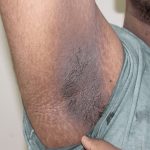ACANTHOSIS NIGRICANS
Introduction:
Acanthosis nigricans is a skin disorder which is characterized by dark, thick patchy skin having a velvety smooth texture that is most commonly observed in the folds of skin. Even though acanthosis is not a disease, it can be a symptom resulting due to certain underlying causes and preexisting conditions. Most often, people who are dark skinned, obese, and who sweat profusely suffer from this condition. It is commonly seen in the folds of skin, and the most commonly affected areas are as below:
- Around Lips
- Neck
- Armpits
- Elbows
- Groins
- Knees
- Knuckles
Practically, the affected persons do not suffer from any discomfort as there is no itching involved, but patients are more concerned due to cosmetic reasons.
In severe cases, the skin may look leathery, very thick like that of an elephant skin.
Causes and risk factors
Some of the prominent causes and risk factors that may make you suffer from Acanthosis nigricans are:
- Diabetic or prediabetes state
- Hyperinsulinemia
- Obesity
- Certain medications, such as birth control pills, thyroid supplements, and growth supplements used for bodybuilding, can create high insulin levels and make one prone to acanthosis nigricans.
- Cancer and cancer medications (Chemotherapy and medications used to prevent the side effects of chemotherapy)
- Endocrine diseases such as hypothyroidism, Cushing’s disease, acromegaly, and PCOD.


Diagnosis
Acanthosis nigricans is easily diagnosed clinically by examining the dark patches. In order to confirm the contributing causative factors, one must go for certain blood investigations, such as insulin, HBA1C, and fasting blood sugar levels. You may notice high levels of insulin which is known to be one of the triggering factors of acanthosis nigricans. The doctor may also suggest a biopsy when in dilemma and to rule other possible causes.
Similar conditions:
a certain form of eczema, lichen planus, and ichthyosis.
